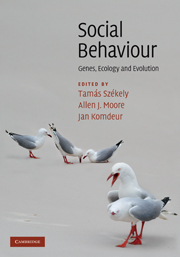Book contents
- Frontmatter
- Contents
- List of contributors
- Introduction: The uphill climb of sociobiology: towards a new synthesis
- Profile: Undiminished passion
- Part I Foundations
- Part II Themes
- Part III Implications
- 16 Personality and individual social specialisation
- Profile: Behavioural ecology, why do I love thee? Let me count the reasons
- 17 Molecular and genetic influences on the neural substrate of social cognition in humans
- Profile: Anonymous (and other) social experience and the evolution of cooperation by reciprocity
- 18 Population density, social behaviour and sex allocation
- Profile: Social theory based on natural selection
- 19 Social behaviour and speciation
- Profile: Look to the ants
- 20 Social behaviour in conservation
- Profile: The handicap principle and social behaviour
- 21 Prospects for research in social behaviour: systems biology meets behaviour
- Species index
- Subject index
- References
18 - Population density, social behaviour and sex allocation
Published online by Cambridge University Press: 05 June 2012
- Frontmatter
- Contents
- List of contributors
- Introduction: The uphill climb of sociobiology: towards a new synthesis
- Profile: Undiminished passion
- Part I Foundations
- Part II Themes
- Part III Implications
- 16 Personality and individual social specialisation
- Profile: Behavioural ecology, why do I love thee? Let me count the reasons
- 17 Molecular and genetic influences on the neural substrate of social cognition in humans
- Profile: Anonymous (and other) social experience and the evolution of cooperation by reciprocity
- 18 Population density, social behaviour and sex allocation
- Profile: Social theory based on natural selection
- 19 Social behaviour and speciation
- Profile: Look to the ants
- 20 Social behaviour in conservation
- Profile: The handicap principle and social behaviour
- 21 Prospects for research in social behaviour: systems biology meets behaviour
- Species index
- Subject index
- References
Summary
Overview
Evolution and ecology naturally intersect through birth, death and dispersal rates as they determine both population dynamics and individual fitness. However, we still understand very little about the connections between population dynamics, the evolution of individual behaviour patterns and the resulting social interactions. In this chapter, we first review how density affects individuals and discuss various ways in which population density is expected to influence social behaviour, using local competition for resources, reproductive cooperation and mating systems as illustrative examples. Following a brief introduction to evolutionary theory on sex allocation, we consider a few empirical examples from social insects, hermaphroditic fish, breeding birds and group-living mammals to demonstrate some of the observed patterns of sex allocation and the effect of density and social behaviour on these patterns. We then explore how sex allocation in hermaphrodites and sex ratios in cooperatively breeding animals can be used to demonstrate the links between sex allocation, sex ratio and social behaviours, as well as the difficulty and importance of understanding links between ecological and evolutionary dynamics generally. We finish the chapter with a discussion of directions for future empirical and theoretical research.
Introduction
Social behaviour takes diverse and fascinating forms in a wide variety of taxa, as the chapters in this book demonstrate. In this chapter, we examine the links between population density, social behaviour and sex allocation as an illustrative example of the general connection between individual-level processes and population patterns.
- Type
- Chapter
- Information
- Social BehaviourGenes, Ecology and Evolution, pp. 474 - 488Publisher: Cambridge University PressPrint publication year: 2010
References
- 13
- Cited by



